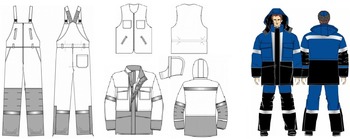Depending on the natural conditions The territory of Russia is divided into several climatic zones.
The average air temperature and wind speed in the winter months for these zones is:
The territory of Russia is huge and is located on the Eurasian continent, therefore climatic conditions in its various regions are quite different.
Each belt has some common features: temperature regime and precipitation patterns depending on the time of year. But at the same time, depending on various factors (for example, the proximity of the ocean), they can vary slightly within the same climate zone.
These differences are especially characteristic for the temperate climate zone, which is divided into four climatic zones. This is the result of the large extent of Russian territory from west to east.

Arctic climate of Russia
In this climatic region there are zones arctic deserts and tundra...
Subarctic climate of Russia
Winters in this climate zone are quite long and cold, although still less severe than in the Arctic...
Moderate continental climate of Russia
The main features of this species temperate climate is a hot summer (in the middle the temperature rises to 30C) and a frosty winter (the temperature drops to - 30C)...
Continental climate of Russia
Formed under the influence of air masses temperate latitudes coming from the west. At the same time, colder Arctic temperatures are moving from north to south. air masses, and to the north there is continental tropical air...
Sharply continental climate of Russia
In this climatic zone continental air of temperate latitudes dominates. Characteristic feature The climate is sharply continental, with little clouds and a small amount of atmospheric precipitation, which fall mainly in the warm season...
Monsoon climate of Russia
As the continent cools in winter, it increases Atmosphere pressure, and cold and dry air masses move towards the ocean, where the air is warmer (water cools more slowly)..
Marine climate (oceanic climate) of Russia
The climate of regions close to the sea, characterized by small daily and annual amplitudes air temperature, high relative humidity, cool summers and mild winters...
Russian subtropics
In Russia, the subtropics lie on the extreme northern border subtropical zone(up to 45°), so the nature here is of a mixed subtropical-temperate nature...
Other climate zones ( tropical, equatorial) are absent on the territory of Russia.
2016.12.05, 15:40
Vasily Kuznetsov
Expert in the selection of workwear
Content:The main purpose of any clothing is to protect the human body from external negative factors (dust, dirt, precipitation, heat, cold, etc.). In this regard, the highest demands are placed on workwear. After all, labor productivity and the success of the development of the enterprise as a whole depend on how comfortable and confident an employee feels in his workplace. So, it is primarily intended for protection against low temperatures. It must comply with GOST R 12.4.236-2007 and be classified relative to climatic zones.
Climate zones (regions)
Territory Russian Federation is very large, the climate in its different parts is noticeably different. In this regard, the map of Russia is conditionally divided into five climatic zones, each of which includes regions and areas with similar parameters of average air temperature and the most probable wind speed in winter. According to this zoning, standards for the free provision of warm special clothing to employees are determined.
The zone with the coldest and harshest climate is called "special" (region IA). It includes all regions of the Far North. average temperature The air temperature here in winter is -25° C, and the average wind speed is 6.8 m/s. It is very difficult to work in such conditions; it is almost impossible to stay outdoors for a long time without negative health consequences.
Areas with even lower temperatures (reaching -60°C) but weaker winds (1.3 m/s) are combined into climatic zone IV (IB region). This arctic zone, including the northernmost edges of the Eurasian continent, lands and islands in the Arctic Ocean. Working conditions in a territory that has long been considered unsuitable for human life are extremely difficult and dangerous.
The most extensive and widespread is climate zone II (III region). It includes regions and republics with sharply and moderately continental climate, with distinct seasons, an average winter air temperature of -18 °C and a wind speed of about 5.6 m/s. Winter is characterized by a relatively long duration and abundance of snow.
Areas with a continental climate and distinct seasons are united in III climatic zone (II region). The average air temperature here in the winter months is -18 °C, and the wind speed is slightly weaker than in areas of climate zone II (3.6 m/s). It is believed that areas of the II and III zones are the most favorable for human life, although they are characterized by weather instability.
A relatively small territory is occupied by areas belonging to climatic zone I (region IV). This is an area where a favorable, subtropical climate prevails, and snow covers can only be seen on the tops of the mountains. The average air temperature here in winter rarely drops below -10°C, and the average wind speed is 5.6 m/s. This belt is characterized comfortable winter, but dry, hot and windy summers.
The zoning of the territory of the Russian Federation by climatic zones can be seen in the diagram:

Protection classes of insulated workwear
The state standard defines four classes of protection against low temperatures, each of which relates to a particular climate zone. The higher the protection class, the harsher the working conditions.
So, overalls I protection class Suitable for work in conditions of I-II climatic zones. This includes sets or individual products with heat-protective properties regulated by GOST R 12.4.185 and corresponding to these climatic zones. For sewing, materials and accessories with physical and mechanical properties that meet established standards are used.
Workwear related to II protection class, has higher heat-protective characteristics, it should be used when working in conditions of the III climatic zone. The requirements for class II workwear are similar to the requirements for class I models; they may have additional thermal protection elements and be made of materials with higher physical and mechanical properties.
III protection class includes insulated workwear necessary for working in climate zone IV. This class of models is subject to more stringent requirements, and additional thermal protection elements are mandatory.
Workwear with the highest thermal protection parameters is used in conditions of a “special” climatic zone and belongs to IV protection class. All models in this class are equipped with a snap-on or stitched insulating lining and must be supplemented with hand and head protection.
Equipment and design of insulated workwear
Insulated workwear can be presented as a set or as a separate type of clothing (jacket, vest, overalls, trousers). The models are completed taking into account working conditions (long stay outdoors, work in a poorly heated room, etc.). As a rule, the set consists of a jacket and trousers. However, trousers can be replaced with overalls. The suit can be complemented with a vest. 
The design of winter workwear can also be different: elements and parts that increase heat-protective properties can be either stitched or removable. Depending on the protection class, winter jackets provide design increases in the thickness of the materials and a loose fit.
When purchasing insulated clothing for workers, the manager must take into account the characteristics of the climate zone, the quality and quantity of layers of insulation. Both too cold and too warm clothes can create discomfort and cause illness.
Depending on natural conditions, the territory of Russia is divided into several climatic zones.
The average air temperature and wind speed in the winter months for these zones is:
| Climate zone | Air temperature in winter months, °C | Wind speed, in winter months, m/s |
| Special |
-25 | 6,8 |
| IV |
-41 | 1,3 |
| III |
-18 | 3,6 |
| I-II |
-9,7 | 5,6 |
I belt
Astrakhan region,
Belgorod region,
Volgograd region,
Kaliningrad region,
Republic of Kalmykia,
Rostov region,
Stavropol region,
II belt.
Bryansk region,
Vladimir region.
Voronezh region.
Ivanovo region.
Kaluga region.
Kursk region.
Leningrad region.
Lipetsk region.
Mari El Republic.
The Republic of Mordovia.
Moscow region.
Nizhny Novgorod Region.
Novgorod region.
Oryol Region.
Penza region.
Primorsky Krai.
Pskov region.
Ryazan Oblast.
Samara Region.
Saratov region.
Smolensk region.
Tambov Region.
Tver region.
Tula region.
Ulyanovsk region.
Chuvash Republic.
Yaroslavl region.
III belt.
Altai Republic.
Amur region.
Republic of Bashkortostan.
The Republic of Buryatia.
Vologda Region.
Irkutsk region (except for the areas listed below).
Republic of Karelia.
Kemerovo region.
Kirov region.
Kostroma region.
Krasnoyarsk Territory (except for the areas listed below).
Kurgan region.
Novosibirsk region.
Omsk region.
Orenburg region.
Perm region.
Sakhalin region.
(except the areas listed below).
Sverdlovsk region.
Republic of Tatarstan.
Tomsk region (except for the areas listed below).
Tyva Republic.
Tyumen region (except for the areas listed below).
Udmurt republic.
Khabarovsk Territory (except for the areas listed below).
Chelyabinsk region.
Chita region.
IV belt.
Arhangelsk region.
(except for areas located beyond the Arctic Circle).
Irkutsk region (districts: Bodaibinsky, Katangsky, Kirensky, Mamsko-Chuysky).
Kamchatka region.
Republic of Karelia (north of 63° north latitude).
Komi Republic (regions located south of the Arctic Circle).
Krasnoyarsk Territory (territories of the Even Autonomous Okrug and Turukhansky District, located south of the Arctic Circle).
Kurile Islands.
Magadan region (except for the Chukotka Autonomous Okrug and the areas listed below).
Murmansk region.
Republic of Sakha (Yakutia) (except for the Oymyakon region and areas located north of the Arctic Circle).
Sakhalin region (districts: Nogliki, Okhtinsky)
Tomsk region (districts: Bakcharsky, Verkhneketsky, Krivosheinsky, Molchanovsky, Parabelsky, Chainsky and the territories of the Aleksandrovsky and Kargasoksky districts, located south of 60° north latitude).
Tyumen region (regions of the Khanty-Mansiysk and Yamalo-Nenets autonomous circles, except for areas located north of 60° north latitude).
Khabarovsk Territory (districts: Ayano-Maisky, Nikolaevsky, Okhotsky, named after Polina Osipeko, Tuguro-Chumikansky, Ulchsky).
Special belt.
Magadan region (districts: Omsukchansky, Olsky, North-Evensky, Srednekansky, Susumansky, Tenkinsky, Khasynsky, Yagodninsky).
Republic of Sakha (Yakutia) (Oymyakonsky district).
The territory located north of the Arctic Circle (except for the Murmansk region).
Tomsk region (territories of the Aleksandrovsky and Kargasoksky districts, located north of 60° north latitude).
Tyumen region (regions of the Khanty-Mansiysk and Yamalo-Nenets Autonomous Okrugs, located north of 60° north latitude).
Chukotka Autonomous Okrug.




